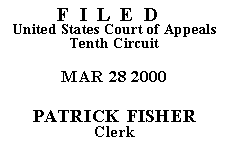

| UNITED STATES OF AMERICA, |
|
Defendant appeals the district court's enhancement of his sentence for illegal re-entry based on a prior conviction. We exercise jurisdiction pursuant to 28 U.S.C. § 1291 and 18 U.S.C. § 3742(a)(2), and affirm.
In 1997, a Washington state court sentenced defendant, an illegal alien, for distribution of a controlled substance. The Immigration and Naturalization Service subsequently deported him. Defendant then illegally re-entered the United States. Eventually, Utah undercover detectives arrested him for selling cocaine. On July 1, 1998, a jury convicted defendant of distribution and possession of cocaine. A Utah state court sentenced defendant to thirty days in jail and thirty-six months' probation. Shortly thereafter, the United States indicted defendant for illegal re-entry in violation of 8 U.S.C. § 1326, and defendant pled guilty.
Defendant's Presentence Report (PSR) recommended a base offense level of 21: 8 points for unlawfully entering or remaining in the United States, 16 points for a previous deportation after conviction in Washington state for an aggravated felony, and -3 points for acceptance of responsibility. The PSR further recommended a criminal history category of IV based on a criminal history score of 7: 3 points for defendant's Washington conviction, 1 point for defendant's Utah conviction, 2 points for committing an offense while on probation, and 1 point for committing an offense less than two years after release from prison.
At sentencing, defendant objected to the addition of one criminal history point for his Utah conviction. He claimed that the district court should not count his Utah conviction as a prior offense because the Utah offense occurred at the same time and during the same course of conduct as the illegal re-entry offense. The district court denied the objection, and defendant now appeals his sentence.
We review de novo a district court's legal interpretation of the guidelines, and we review for clear error its underlying factual findings. United States v. Cuthbertson, 138 F.3d 1325, 1326 (10th Cir. 1998). Defendant contends the district court erred in treating his Utah drug conviction as a prior offense in calculating the criminal history portion of his guideline sentence. We disagree.
The United States Sentencing Guidelines ("U.S.S.G.") provide that a district court should use a defendant's "prior sentence" in calculating his criminal history. U.S.S.G. Manual § 4A1.1 (1998). Section 4A1.2(a)(1) defines a prior sentence as "any sentence previously imposed upon adjudication of guilt . . . for conduct not part of the instant offense." Conduct is part of the instant offense only if it is "relevant conduct" to the instant offense. Id. § 4A1.2 commentary n.1. Thus, "a conviction will not be treated as a prior sentence (and no criminal history points can be added) so long as the underlying conduct meets the definition of relevant conduct." United States v. Keifer, 198 F.3d 798, 801 (10th Cir. 1999).
Defendant claims that his Utah conviction constitutes relevant conduct as defined in U.S.S.G. § 1B1.3(a)(2). Under this section, conduct is relevant only if three prerequisites are met.
First, there must be a finding that the offense in question
involved conduct described in §§ 1B1.3(a)(1)(A) and (B).
Second, the offense must be the type of offense that, if
the defendant had been convicted of both offenses, would
require grouping with the offense of conviction for
sentencing purposes under U.S.S.G. § 3D1.2(d). Third,
the offense must have been "part of the same course of
conduct or common scheme or plan."
United States v. Taylor, 97 F.3d 1360, 1363 (10th Cir. 1996) (quoting U.S.S.G. § 1B1.3(a)(2)).
Here, the district court found that defendant's Utah drug conviction and the instant offense of illegal re-entry were not sufficiently connected or related to be considered part of the same course of conduct. Therefore, the district court held that defendant's prior Utah conviction did not constitute relevant conduct. Two offenses are part of the same course of conduct where there is "sufficient similarity and temporal proximity [between the acts] to reasonably suggest that repeated instances of criminal behavior constitute a pattern of criminal conduct." Id. at 1365 (internal quotation marks and citation omitted). Commentary to the Guidelines further provides that
[o]ffenses . . . may . . . qualify as part of the same course
of conduct if they are sufficiently connected or related to
each other as to warrant the conclusion that they are part
of a single episode, spree, or ongoing series of offenses.
Factors . . . to be considered . . . include the degree of
similarity of the offenses, the regularity (repetitions) of the
offenses, and the time interval between the offenses.
U.S.S.G. § 1B1.3 commentary n.9(B).
The offenses of illegal re-entry and distribution and possession of cocaine are not similar. Although defendant committed these crimes within a relatively short time interval, these offenses do not suggest a pattern of criminal conduct or warrant the conclusion that they are part of a single episode, spree, or ongoing series of offenses. Thus, we conclude the district court did not clearly err in finding that defendant's Utah conviction and his illegal re-entry offense were not part of the same course of conduct. The district court's "course of conduct" finding was sufficient to preclude defendant from meeting the prerequisites of the § 1B1.3(a)(2) relevant conduct test. See Keifer, 198 F.3d at 802. Accordingly, the district court properly used defendant's Utah conviction to calculate his sentence.
AFFIRMED.
ENTERED FOR THE COURT,
Deanell Reece Tacha
Circuit Judge
*.This order and judgment is not binding precedent, except under the doctrines of law of the case, res judicata, and collateral estoppel. This court generally disfavors the citation of orders and judgments; nevertheless, an order and judgment may be cited under the terms and conditions of 10th Cir. R. 36.3.